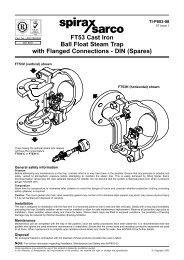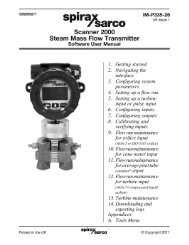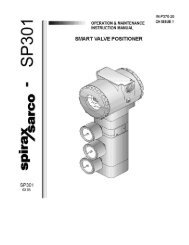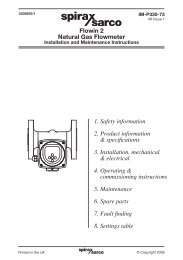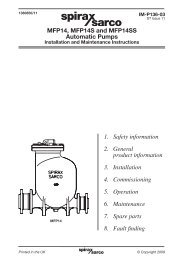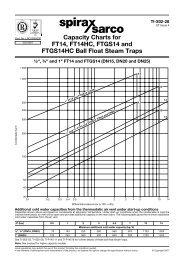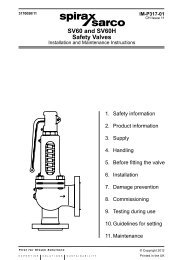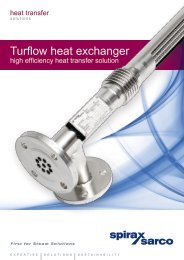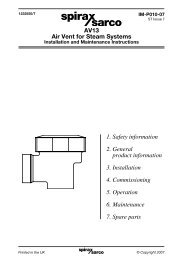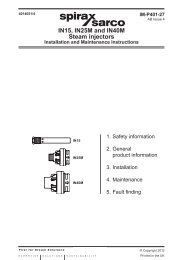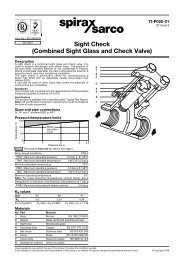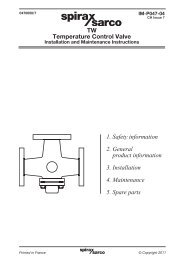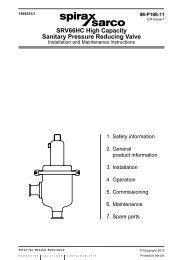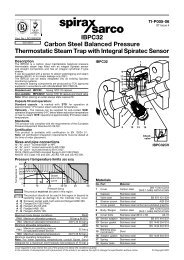Scanner 2000 Steam Mass Flow Transmitter ... - Spirax Sarco
Scanner 2000 Steam Mass Flow Transmitter ... - Spirax Sarco
Scanner 2000 Steam Mass Flow Transmitter ... - Spirax Sarco
You also want an ePaper? Increase the reach of your titles
YUMPU automatically turns print PDFs into web optimized ePapers that Google loves.
Section 2 <strong>Scanner</strong> ® <strong>2000</strong> microEFM<br />
Measuring Natural Gas via a Differential Pressure Meter<br />
Note This section contains installation guidelines for orifice and cone meters. If installing the <strong>Scanner</strong> <strong>2000</strong><br />
with an averaging pitot tube meter, refer to manufacturer instructions for installation.<br />
Best Practices for Orifice and Cone Meter Installation<br />
To ensure measurement accuracy, ensure that the meter run complies with the following AGA-3 and ISO 5167<br />
guidelines, as applicable:<br />
• Do not place unit near vents or bleed holes that discharge corrosive vapors or gases.<br />
• Consider the orientation of the meter run when determining the best position for mounting the <strong>Scanner</strong><br />
<strong>2000</strong>.<br />
– If the <strong>Scanner</strong> <strong>2000</strong> is mounted to a horizontal pipeline, make sure process connections are at the top<br />
of the line, and mount the <strong>Scanner</strong> <strong>2000</strong> above the pressure connections at the pipe.<br />
– If the <strong>Scanner</strong> <strong>2000</strong> is mounted to a vertical pipeline, install the sensor above the differential pressure<br />
source connections, or install a condensate (drip) pot to prevent the accumulation of liquid in interconnecting<br />
tubes. Slope all tubing upward at least 1-inch/linear foot to avoid liquid entrapment.<br />
• Mount the <strong>Scanner</strong> <strong>2000</strong> as near level as possible such that the operator has a clear view of the LCD, and<br />
can access the keypad easily when the enclosure cover is removed. The location should be as free from<br />
vibration as possible.<br />
• Make sure the high port of the sensor (marked “H”) is connected to the upstream side of the meter run.<br />
• <strong>Flow</strong> should remain subsonic throughout the measuring section and should be single phase.<br />
• Pipe diameters (D) should be between 2 in. (50 mm) and 39 in. (1000 mm) per ISO 5167; or greater than<br />
2 in. (50 mm) per AGA-3.<br />
• Pipe Reynolds numbers must be above 5000.<br />
• d (orifice diameter) must be greater than or equal to 0.45 in. (11.5 mm).<br />
• β (diameter ratio) must be greater than or equal to 0.1 and less than or equal to 0.75.<br />
• Gauge lines should be of uniform internal diameter and constructed of material compatible with the fluid<br />
being measured. For most applications, the bore should be no smaller than ¼ in. (6 mm) and preferably,<br />
3/8 in. (10 mm) in diameter. The internal diameter should not exceed 1 in. (25 mm). If high-temperature<br />
fluids are likely to be encountered, make sure the measuring tube used is rated for the anticipated temperature<br />
range.<br />
• Gauge line length should be minimized to help prevent pulsation-induced errors.<br />
• Gauge lines should slope downward to the meter at a minimum of one inch per foot.<br />
• If gauge lines must slope in more than one direction, do not allow more than one bend and install a liquid<br />
or gas trap, as applicable. A liquid trap should be installed at the lowest point in a gas service installation.<br />
• Gauge lines should be supported to prevent sag and vibration.<br />
• Where pulsation is anticipated, full-port manifold valves with a nominal internal diameter consistent with<br />
the gauge lines are recommended.<br />
If the <strong>Scanner</strong> <strong>2000</strong> is mounted to a cone meter, consider the following best practices in addition to the best<br />
practices listed above.<br />
• Position the cone meter so that there are zero to five pipe diameters upstream of the meter and zero to<br />
30



